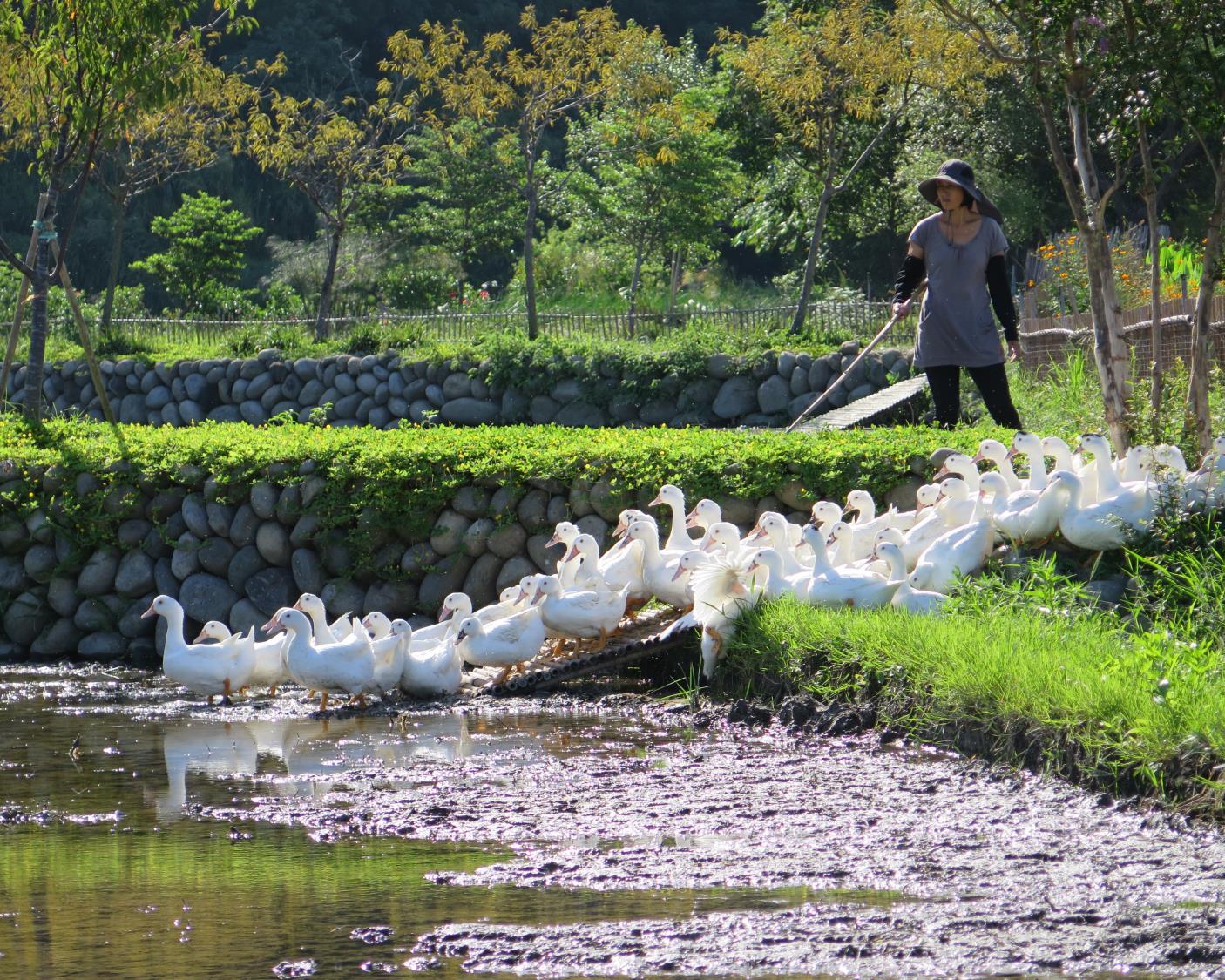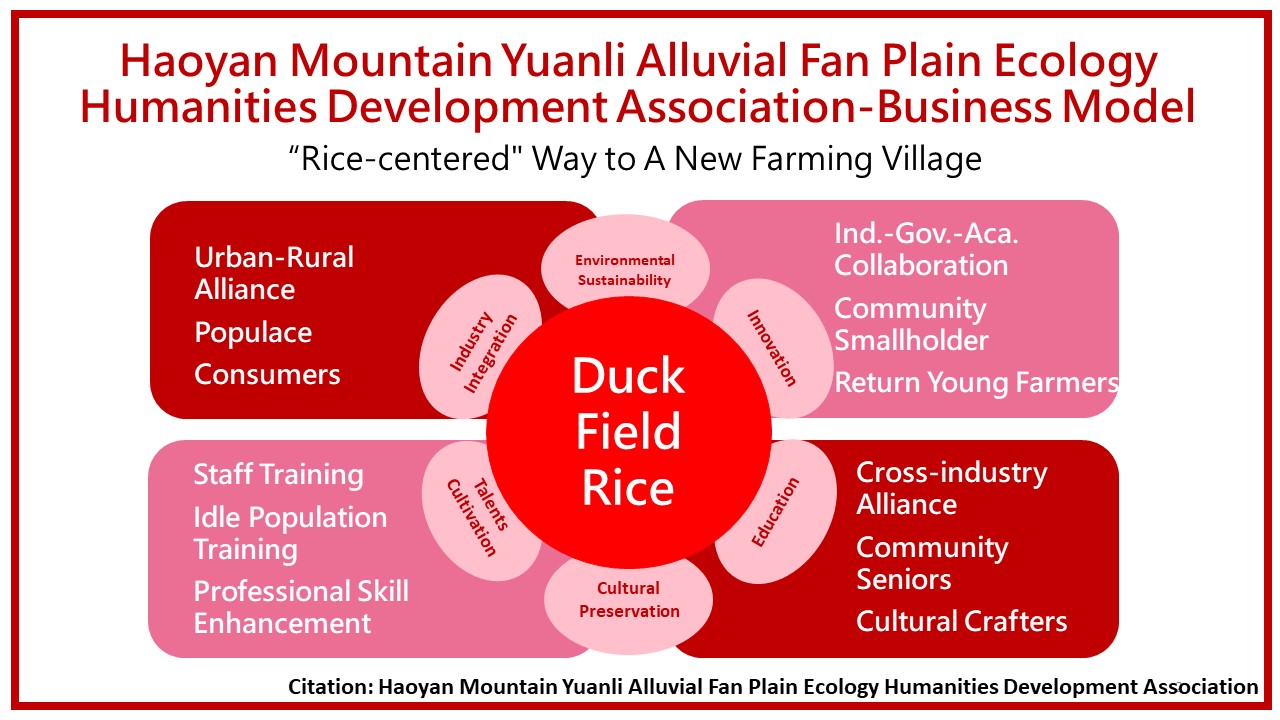
Recently, the concept of Symbiotic Farming is popular. Whether the Aquaponics that people can experiment with on their balconies, the Rice-duck Symbiosis that professional farmers raise ducks while growing rice, or the intelligent Fish and Electricity Symbiosis, all of which are based on the organic and non-toxic basis, seeking the ecological balance of each species in its place.
In Taiwan, there is a group of rice farmers who have natural ecology mission. They reclaimed the traditional Rice-duck farming many years ago, which not only planted organic rice but reappeared the prosperous ecology scenery from their childhood by building up the ecology system. It is the development history of Duck Field Rice in Yuanli Township, Miaoli County.
The principle of Rice-duck Symbiosis is simple. The farmers raise ducks while growing rice but only drive the ducks into the rice fields in the growing season so that they will eat the pests, snails, and weeds. The well-fed ducks later defecate in the rice fields as natural fertilizer, growing the rice organically without pesticide spraying.
"How can the rocks be so beautiful around the pond?" Mr. Hsiao Ming-hung, the CEO of Haoyan Mountain Yuanli Alluvial Fan Plain Ecology Humanities Development Association, has been asked. "It must cooperate with the humidity, sunlight, and water to develop the unique microclimate here. The wilderness fun cannot be replicated."
Youth Volunteers Devoted 20 Years to Rebuilding the Diversity of Ecology Landscape
The "Wilderness fun" said by Mr. Hsiao is the proud achievement: the diversity of ecology landscape of Duck Field Rice. To achieve the mission, the Association asked a group of unpaid young and strong volunteers who have been working for 20 years to recreate the rich flavor of the old Taiwan rural village.
For the "Pebble Masonry" ridges as an example, Mr. Hsiao explained that there were many concrete piers had been built in many small ditches of the local fields when the Association was first established. The main purpose was to unify the precious water resources, otherwise, whenever water was released from the reservoirs or upstream, about 1/3 of the flowing water here would either evaporate or leak.
However, the concrete piers took a high price on the entire field ecology. "Many creatures have disappeared," added Mr. Chen Yong-jin, the Chairman of the Association. "When I was a kid, the ditches were made of stacked stones, and whenever the water was cut and dredged, there were fishes to catch in the ditches. Now, most of the farmland no longer can catch fish but here."
The White-breasted Waterhen which only Lives in Good Environment Reappears
Small and medium resident birds such as White-breasted Waterhen like to nest in the rice fields and reed beds near the water. Although it will break the tice ears to make nests, it does not affect the growth of rice so not a pest bird. "The Waterhens have the characteristic of only choosing a good environment to breed," Mr. Hsiao pointed out, "so it left us a long time ago in the process of urbanization."
With the stance of "Not to force a complete restoration but to rebuild the biodiversity of the environment," the members of the Association began to stack pebbles of various sizes on the field's waterways as the retaining wall or revetment in the ditches. Since pebbles have proper pore spaces, they can provide a habitat for many kinds of organisms and meet the requirements of ecological permeability and natural aesthetics, which is the basic method of ecological restoration.
In 2007, the members found White-breasted Waterhen in the field again! When a female colleague found a nest of eggs, so the members began a tracking plan. They first asked an expert to guide them in setting up cameras and then took pictures of the Waterhens overjoyed. Because it represented an initial result of ecological restoration! Since then, dragonflies, spiders, small yellow ants, and giant black ants have become evidence of their ecology recovery.
Planted Non-toxic Organic Rice after Rehabilitating Dragonflies and Spiders
Mr. Hsiao recalls that since they applied Multi-Employment Promotion Program (MEPP) and Empowering Employment Program (EEP) of the Ministry of Labor, they have been actively learning from experts at Taoyuan Aquatic Plant Research Center and National Chung Hsing University about natural landscape restoration and teaching resource construction projects. They just realized that more than 10 species of dragonflies had been rehabilitated at Duck Field Rice; Mr. Luo Ying-yuan of the Endemic Species Research Institute also introduced more than 60 species of spiders.
Dragonflies and spiders are the natural enemies of farming pests. Small yellow ants and giant black ants are the scavengers that keep the fields clean. Therefore, the Association takes the next step: growing non-toxic organic rice. It leases a total area of about 3 to 4 hectares of land from the landlord, and each hectare yields 7,000-8,000 tkgs of rice, which is only 60% of the average land, but the unit price is nearly two times higher, said Mr. Hsiao.
He explained that the weather is more rainfall, hot, and humid this year. If he wants the rice yield in large and beautiful, it is necessary to use pesticides. However, Duck Field Rice doesn't spray pesticides and each seedling has a maximum of 20 stalks, which is 10 stalks less than others so that the rice is not susceptible to rice blast. What really reflects the excellent ecology value is that "After the rice is cooked and reheated overnight, pesticide rice tastes terrible!"
Develops "Rice-Centered" Business Value-Added
In addition, the talents outside of the farming industry have also enabled the rice farm to develop "Rice-centered" business value-added, one of which is the traditional Hakka blue dyeing technique. Duck Field Rice invited Mr. Yeh Jin-yum, the chairman of Taiping Blue in Taiping District, Taichung City, to train the young people. After the training, those young people became lecturers at the Workshop and led trip visitors to the fun of dyeing cloth. "Young people have stronger learning capability and are more interested in jobs other than farming. So we actively seek young people who are interested and let them try without limit." Mr. Hsiao admitted.
Now, in addition to the blue dyeing experience course, the team hired by the Empowering Employment Program (EEP) has also developed products such as DIY rice straw weaving, hand-made fans, bamboo baskets, and the nostalgic handwritten paper that young customers love. Before the outbreak of COVID-19, the Association was able to take 2 one-day tour groups with more than 30 people per tour bus. The annual revenue has grown steadily by 10% each year cumulatively.
Plains, Cliffs, and Canals: Three Landscapes in One
Haoyan Mountain Ecology Community is located at the mountain root, the top of Daan Creek Alluvial Fan, and the most extensive pebble alluvial plain. Regarding geography, it has the beauty of the vast plain in the front, the wonderful cliffs in the back, and the winding and dense canals. The three scenes in one make the conditions of developing Organic Farming combined with leisure function.
The Association has made those excellent geographical advantages to the transformation decision. There are several details: The Association insists on restoring the diversity of the ecological landscape, which lays the foundation of diversified development for the transformation into leisure tourism. In addition to experiencing the fun of Rice-duck symbiosis, it also designs handicraft courses of reproduction blue-dyed cloth, allowing the traditional farming fun as the additional elements inject more vitality into the township industries.
However, professional farmers may be good at catching dragonflies and spiders, or managing ducks and restoring White-breasted Waterhen, but developing business opportunities for leisure tourism is a different skill. Therefore, when the Association began to apply the Ministry of Labor's Empowering Employment Program (EEP), it also considered the cultivation of local talents to continue the sustainable ecology concepts on one hand, and to progress with the generation on the other.
By maintaining the land and the ecology so that it can live on, the industry will have room to upgrade and the value will be seen. This also in turn the real profits to the Association, the members, and the employees, giving them the motivation to continue their efforts and creating a virtuous cycle of agriculture, economy, and ecology.
Haoyan Mountain Yuanli Alluvial Fan Plain Ecology Humanities Development Association (Duck Field Rice) Office Website and Facebook Page
~Mr. Hsiao Ming-hung said, the CEO of Haoyan Mountain Yuanli Alluvial Fan Plain Ecology Humanities Development Association.
-2020 Miaoli County Cultural Products Certification Selected as Top 10 Cultural and Creative Product
-2018 Miaoli County Cultural Products Certification received 2 Local Characteristics Awards
-2006, 2007, and 2012 Multi-Employment Development Program(MEPP) Award of Excellence

▲Business Model
▲The name "Duck Field Rice" comes from the place that raises those ducks which are specialized in eating the pest snails. The "Rice-duck Symbiosis" is promoted as a model of symbiosis, coexistence, and mutual benefit.
▲Academic ecological surveys are also normal at Duck Field Rice(the Association), especially the rehabilitation of more than 60 species of spiders, which play a silent role in stabilizing the balance of biological populations and are a major contributor to rebuilding biodiversity. (Pictures Provide: Haoyan Mountain Yuanli Alluvial Fan Plain Ecology Humanities Development Association)
Case Story: Multi-Employment Promotion and Empowering Employment Program
Interviewee: Haoyan Mountain Yuanli Alluvial Fan Plain Ecology Humanities Development Association (Duck Field Rice)
![]()
This work is licensed under a Creative Commons Attribution-NoDerivatives 4.0 International License.
Please attribute this article to“Workforce Development Agency, Ministry of Labor”
